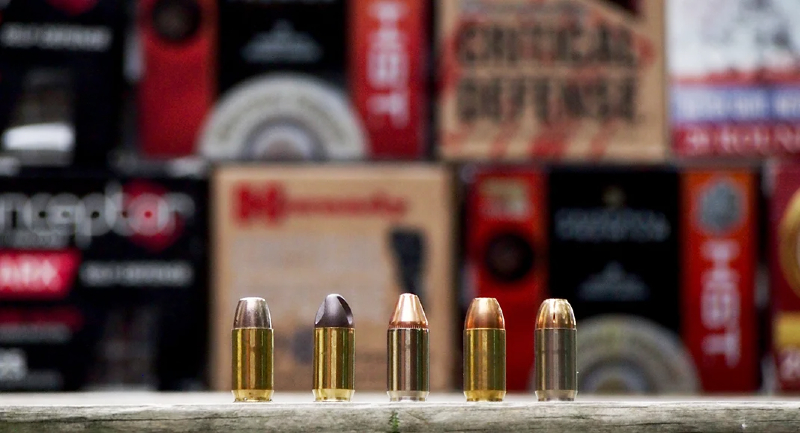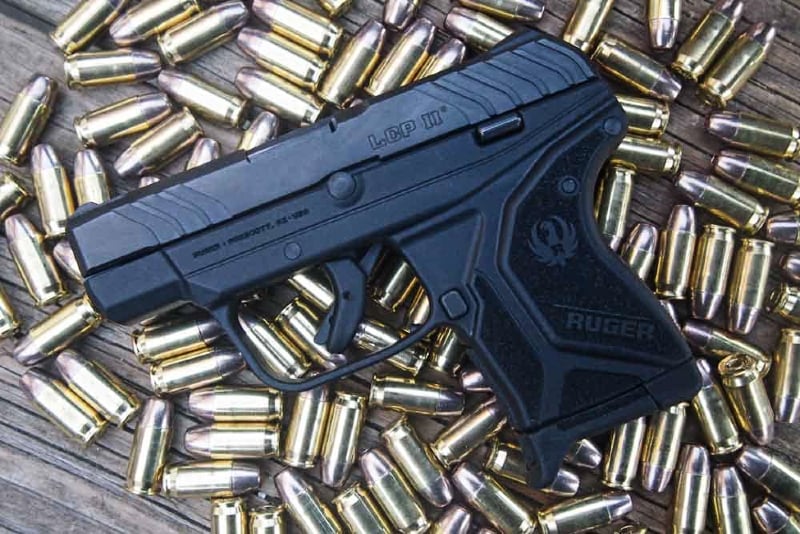The 380 ACP has been around for a long time and just might be one of the most frequently argued-about cartridges that’s currently in use. Some claim it’s perfect for self-defense while others say it is only barely sufficient. Some say it’s worthless and should never be relied upon to save your life.
Of course, technology has made a lot of ballistic advantages possible, and that always changes things when it comes to ammo. Is 380 ACP a worthwhile defensive cartridge? Read on to find out more, check out some charts, and decide for yourself.

Who invented 380 ACP?
This might surprise a few readers, but the cartridge was invented by none other than John Moses Browning. Yes, the same John Moses Browning that created the 1911 and 45 ACP.
A somewhat common point of confusion is the belief that its parent cartridge is the 9x19mm Parabellum. It’s true that the 9mm was designed a little bit earlier than 380 ACP, but the 9mm is not its parent cartridge. In reality, the 380 ACP was designed by Browning based on an earlier cartridge design of his, the 38 ACP (this is just one reason adding that “0” to 380 ACP is important).
Browning specifically created it for use in blowback pistols, which do not have a barrel locking mechanism. This makes the platform cheaper to produce overall but does mean the gun cannot handle higher-pressure rounds. If a gun chambered in 380 ACP is rated as safe for use with +P/+P+ ammo, odds are it has a much heavier slide to ensure that it cycles properly.

Specifications
Charts are often the answer to all your ammo questions (or at least some of them). The 380 ACP’s dimensions are worth referencing, especially if you intend to compare them to other rounds. Check out the specs in the chart below and note how it compares to 9mm. The reason for this comparison is that the most common caliber debate over this cartridge tends to be 380 ACP vs 9mm.
| Cartridge | 380 ACP | 9x19mm Parabellum |
| Designed By | John Moses Browning | Georg Luger |
| Year Designed | 1908 | 1901 |
| Production | 1908-Present | 1902-Present |
| Country of Origin | United States | Austria |
| Case Type | Rimless, Straight | Rimless, Tapered |
| Bullet Diameter | 0.355 inches | 0.355 inches |
| Neck Diameter | 0.373 inches | 0.380 inches |
| Base Diameter | 0.374 inches | 0.391 inches |
| Rim Diameter | 0.374 inches | 0.392 inches |
| Rim Thickness | 0.045 inches | 0.050 inches |
| Case Length | 0.680 inches | 0.754 inches |
| Overall Length | 0.984 inches | 1.169 inches |
| Maximum Pressure | 21,500 psi (SAAMI) | 35,000 psi (SAAMI) |
As you can see, 9mm is larger than 380 ACP. You frequently hear fans of 380 ACP state that it has the same bullet diameter as 9mm, meaning it must be virtually the same round. That isn’t accurate.
The case length, overall length, and the maximum pressure of 380 ACP compared to those of 9mm tell you a great deal. 380 ACP is loaded at a pressure that’s 13,500 psi lower than that of 9mm and is significantly shorter. Sure, bullet diameter is the same between the two cartridges, but there’s a lot more to ammo than diameter.

Ballistics
Going by the FBI ballistic gel test standards for determining whether or not a specific load penetrates sufficiently, the results tend to vary between “not quite,” “just barely,” and the occasionally “surprisingly good.” For example, check out the following loads:
| Ammunition | Hornady Critical Defense 380 ACP 90-grain FTX | Remington Ultimate Defense 380 ACP 102-grain JHP | Federal Premium Punch 380 ACP 85-grain JHP |
| Muzzle Velocity | 1000 feet per second | 940 feet per second | 1000 feet per second |
| 25-yard velocity | Unavailable | 920 feet per second | 949 feet per second |
| 50-yard velocity | 910 feet per second | 901 feet per second | 907 feet per second |
| 75-yard velocity | Unavailable | 883 feet per second | 869 feet per second |
| 100-yard velocity | 841 feet per second | 866 feet per second | 835 feet per second |
| Muzzle Energy | 200 foot-pounds | 200 foot-pounds | 189 foot-pounds |
| 25-yard energy | Unavailable | 192 foot-pounds | 170 foot-pounds |
| 50-yard energy | 165 foot-pounds | 184 foot-pounds | 155 foot-pounds |
| 75-yard energy | Unavailable | 177 foot-pounds | 143 foot-pounds |
| 100-yard energy | 141 foot-pounds | 170 foot-pounds | 132 foot-pounds |
| Penetration Depth* | 8.9-inch average | 15.6-inch average | 10.9-inch average |
*Averages are of five shots fired into bare gelatin.
The FBI ballistic gel tests set a minimum penetration depth of 12 to 18 inches. Penetration under 12 or over 18 is considered less than ideal and the so-called “sweet spot” is typically between 14 and 16 inches. That doesn’t mean rounds that penetrate under 12 inches are worthless for defensive purposes, just that they will not penetrate as effectively as certain others.

Generally speaking, 380 ACP doesn’t penetrate deeply. It’s also important to note that different defensive loads are designed for varying uses, which means the outcomes will differ. For example, Hornady Critical Defense is made for fantastic, consistent penetration, but the heaviest emphasis is not on penetration depth. The Hornady Critical Duty line is made specifically to deliver excellent penetration, especially through barriers. It all depends on the specific load’s design.
As you can see in the chart above, 380 ACP tends to be a little underwhelming for penetration depth. That does not necessarily mean it’s a bad idea for self-defense use.

What do medical and law enforcement professionals say about the cartridge?
There are many opinions on 380 ACP out there, and they’re all colored by the life experience of the person being asked. For this reason, an emergency room doctor might tell you they’ve never seen an attacker dropped by 380 ACP—only wounded. Another surgeon might say they do see an inordinate number of 380-ACP-related deaths. An LEO may have seen a lot of successful self-defense incidents involving 380 ACP, but does that directly translate to the 380 ACP being superior to other cartridges? Not exactly.

According to the gunsmith and now-retired police Sergeant and US Army veteran Tim Crawford, his experiences made up his mind fast on the cartridge:
Never 380 ACP as a defensive round. I made a run one night on a guy who had been shot 7 times with a 380 ACP. It was a drug deal gone bad. [After being shot] the guy whooped the shooter’s a** and took his gun away from him. Made my mind up on it. And the guy lived.
In these cases, the common-use factor comes into play. Which cartridges are most frequently used for self-defense? Probably 380 ACP and 9mm, although there are no official records to back it up.

Is 380 ACP better than 9mm?

If we’re speaking ballistically, the 9mm does outperform 380 ACP. The days when the only micro-compact pistols available for deep concealment were chambered in 380 ACP—or smaller—are gone. Today, all manner of micro 9mms are on the market.
For felt recoil, 380 ACPs tend to be snappy little guns. There are some heavier, larger-framed models where their sheer size helps mitigate felt recoil, but overall it wouldn’t be accurate to say the 380 ACP is “easier” to shoot than 9mm. Even if you run a micro 380 ACP and a micro 9mm alongside one another with identical platforms, you’re not likely to find the 380 ACP to be a flatter shooting gun.

Should you get a 380 ACP for self-defense?
It’s a matter of personal preference whether you own a firearm in this chambering for self-defense use. You can examine the charts in this article and comes to some conclusions about its effectiveness. Of course, with the right gun and ammo combination, you’ll get better performance out of the cartridge for penetration and expansion. Here’s the question: If you have to stretch to make it work, is it worth it?
What do you think? Tell us your thoughts about the 380 ACP in the comments section below.



Pingback: Ammo Test—Federal Micro HST .380 ACP - The Mag Life()